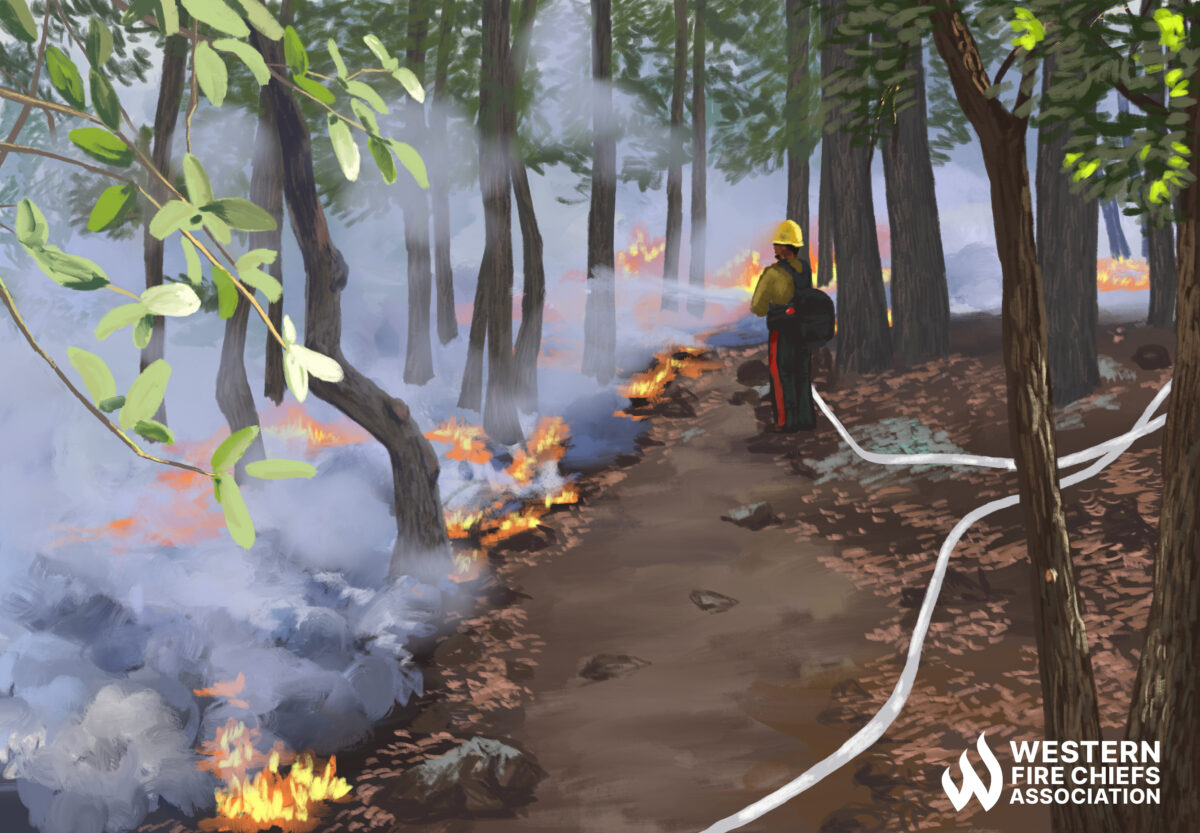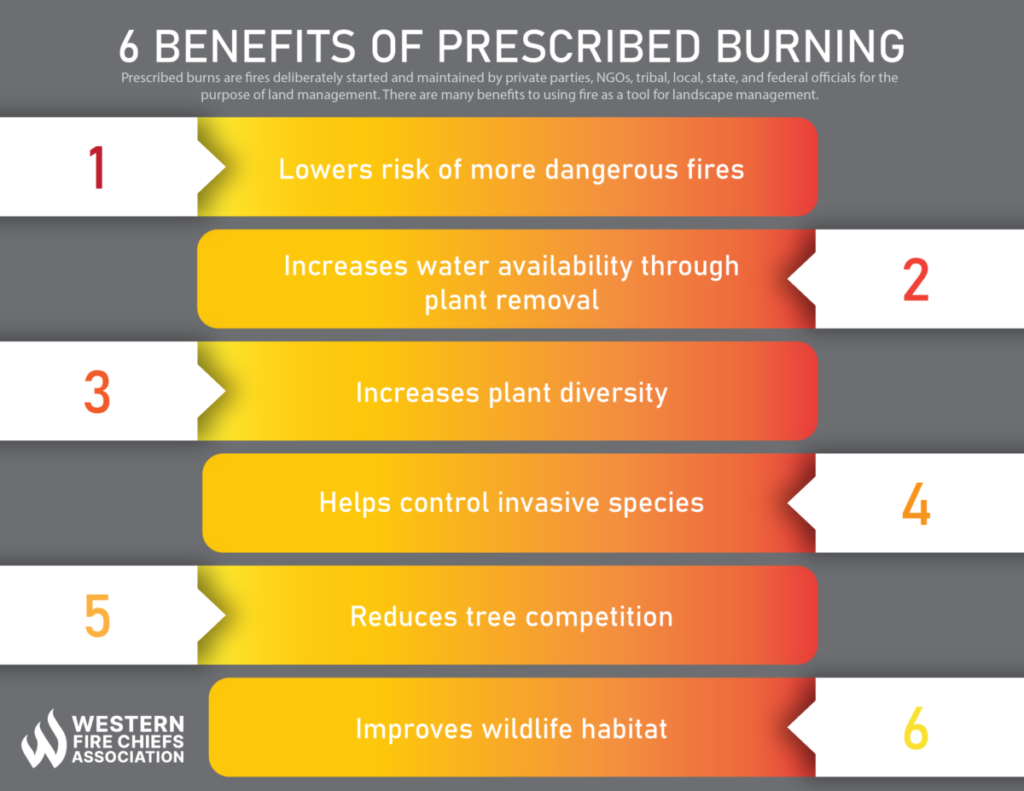Fire Pit Safety Tips
Stay safe around the campfire with tips from the Western Fire Chiefs Association. Learn essential precautions and practices for a worry-free outdoor campfire.
Is prescribed burning good or bad? Learn about the pros and cons of prescribed burning with expert guidance from the Western Fire Chiefs Association (WFCA).
Published:November 29, 2022
Edited:March 4, 2024

Is prescribed burning good or bad? Learn about the pros and cons of prescribed burning with expert guidance from the Western Fire Chiefs Association (WFCA).
Prescribed burns are fires deliberately started and maintained by private parties, NGOs, tribal, local, state, and federal officials for the purpose of land management. These fires are started in specific, pre-determined locations and carefully controlled, so they do not cause harm to people, animals, and property.
You may have heard the term “controlled burn” before and think that it is the same thing. However, prescribed burns are different from controlled burns in that they must adhere to specific weather conditions, soil moisture, terrain, labor and equipment, ignition procedures, contingency plans, and more.1 A controlled burn is a fire that someone starts with the intention to control it, like a campfire.
A campfire can easily turn into an uncontrolled wildfire if the person who started it does not take the necessary precautions. Prescribed burns rarely become wildfires because officials carefully adhere to the parameters of their prescriptions.
There are many advantageous reasons to conduct regular prescribed burning, but there are also arguments against this practice. While the arguments against prescribed burns are academically valid, all prescribed burns are an effective way to reduce the risk of catastrophic fires. The temporary risks of prescribed burns work to prevent those same risks from happening on a much larger and deadlier scale in the case of an uncontrolled wildfire.
Below are the benefits of prescribed burning, as well as the commonly cited disadvantages.

Prescribed burning helps clear out densely grown vegetation on forest floors. Over time, the ground can become thick with dead leaves, twigs, shrubs, and small trees. This overabundance of material serves as fuel for wildfires.
Strangely enough, the easiest way to get rid of excess fuels is to start a fire and let the flames burn them up. By doing so in a carefully prescribed manner when conditions are not too dry or windy, it is possible to lower the risk of more dangerous fires starting in the same area by accident.
Prescribed burns have the potential to increase water availability for animals that live in the area. They do so by burning away plants that are placing a high demand for water in the soil. When these plants – usually low-lying vegetation – are destroyed, the source from where they draw their water retains more of its contents, thus leaving more for animals to drink.2
Prescribed fires help increase plant diversity. This may sound counterintuitive, but when you burn away vegetation that has grown thick and dense, you allow room for other species of plants to grow in their place.2
Fires, under prescribed conditions, can help control invasive plant species.2 These are plants that have managed to take root outside of their normal habitat, and lack the natural restrictions on growth that would be found in their native regions.
When a species of plant invades an ecosystem, it competes for precious soil and water resources with other species. Prescribed burns can destroy these invaders and give native plants a chance to reestablish themselves in the area.
Prescribed burns are often used to reduce the number of trees that are using too much water and soil resources, as well as shading out other trees. This reduces tree competition so that more types of plants can exist in the same ecosystem.2
Fires benefit wildlife in many different ways. They clear away dead material and provide ground space for new plant species to grow, which will serve as food and cover for many different types of animals. In addition, prescribed burns clear away vegetation that has been allowed to grow too long without a fire, rendering it too tall for deer and other animals to eat.2 The new vegetation that grows after the fire is much more accessible for herbivores.
The following are common arguments against prescribed burning. However, prescribed burns work to reduce or eliminate these risks from taking place on a much larger scale in the event of an uncontrolled wildfire in the same area.
Any fire, even if it is prescribed, poses a risk to people, property, and animals. If even one condition is not just right, or even if the entire procedure goes perfectly, fire is naturally a wild, unpredictable element. It can always turn into a wildfire, at which point it could spread and destroy homes, injure humans, and displace animals from their natural habitats – or even kill them.
Even when a fire is under the complete control of fire experts and officials, it still reduces air quality (if only temporarily). The smoke, ash, and other particulate matter that it produces make breathing difficult for people and animals in the area.3 It also reduces visibility, which can lead to vehicle accidents and other problems.
Fires can significantly reduce the quality of natural drinking water. They do so by disrupting the soil and causing debris, sediment, and contaminants to flow into nearby streams, which can make the water dangerous to drink.3
If a prescribed burn turns into a wildfire, it could cost billions of dollars in resources and property destruction.
Fires, even if they are prescribed, should never be taken lightly. That is why it is important to learn about fire safety and to be prepared for a fire in any situation.
Stay safe around the campfire with tips from the Western Fire Chiefs Association. Learn essential precautions and practices for a worry-free outdoor campfire.
Discover essential firework safety tips to ensure a dazzling display without accidents. Learn how to celebrate responsibly with expert guidance from WFCA.
Explore the role of AI in wildfire prediction with guidance from the WFCA. Learn how advanced algorithms and data analytics enhance early detection and response.